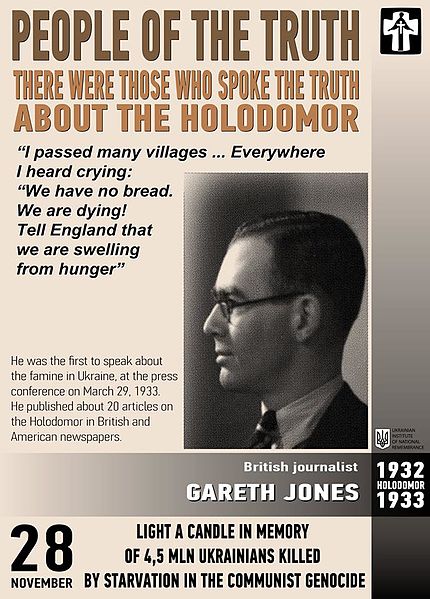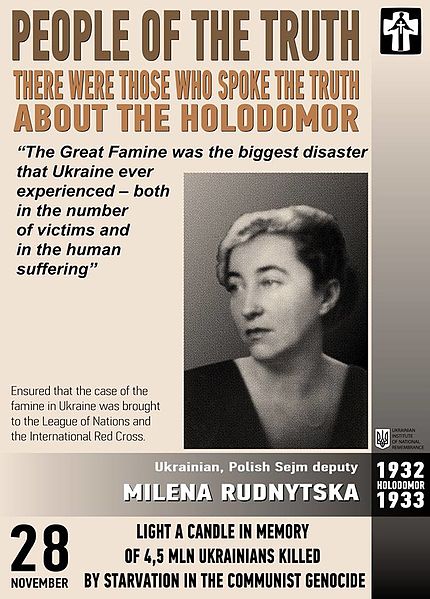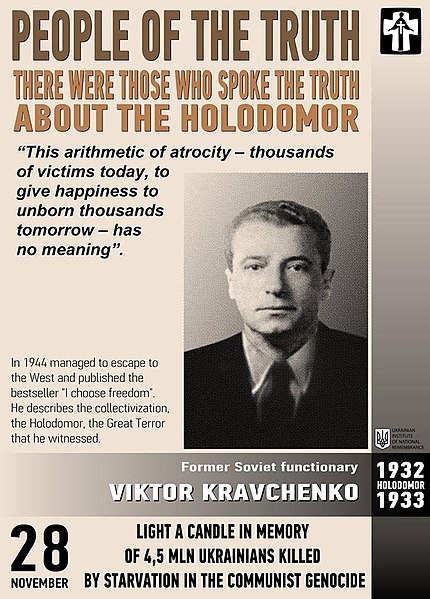
The Holodomor was a famine in Ukraine that lasted from spring 1932 to July 1933 and killed millions of people. Historians disagree on the exact death toll, depending on which research methods they use. Estimates range from 3.5 to 7 million. A few people believe up to 20 million were killed, but most historians believe such a figure is extremely exaggerated and has no basis in facts.

The word Holodomor derives from holod (hunger) and mor (plague). Loosely, it means “death/killing by hunger/starvation.” This etymology draws from the expression moryty holodom, to inflict death by hunger. The verb moryty means “to torment, to poison, to drive to exhaustion,” and its perfective form, zamorty, means “to kill or drive to death by hunger or exhausting work.”
The famine was first referred to as the Holodomor in the Czech magazine Večernik on 17 August 1933. Various other terms were used through the ensuing decades, such as hunger catastrophe, famine catastrophe, and artificial famine. Holodomor became the accepted, mainstream word by the 1980s.

One of the causes of the Holodomor was dekulakization, the mass arrests, deportations, and murders of kulaki, well-off farmers with a lot of land. Coupled with forced collectivization, this radically changed the Ukrainian landscape. With all farming now under state control, people were compelled to turn over all extras from their harvests. Cops and authorities also confiscated any other food they wanted.
Kolkhozi (collective farms) who failed to meet their quotas or turn over the excess were blacklisted and forced to give the state fifteen times their quota. They also lost the rights to trade and receive deliveries. Anyone who didn’t obey was arrested for treason.

In November 1932, Ukraine was ordered to provide one-third of the entire grain supply for the entire USSR. The borders were sealed in January 1933 to prevent starving, desperate people from moving to other republics. By the end of February, 190,000 peasants had been caught trying to cross the border and were forced home to starve.
Even after the target grain quota for 1932 was met in January 1933, authorities continued collecting it. Ukraine also had fewer tractors, thus making it harder to harvest.
Even very small items like cherries, pears, and apples were confiscated.

Though Stalin knew about the famine and how many people were dying, he refused to send any aid. On the contrary, people who publicly wrote or spoke the truth were arrested and shot or sent to the GULAG.
The highest death rates by far were in the oblasts (provinces) of Kyiv and Kharkiv. Third place was Vinnytsya, and then came Dnipopetrovsk, Odesa, Chernihiv, and Stalino (now Donetsk). The oblast with the lowest death rate was Tyraspil, then part of an autonomous Moldavian Republic. Many people were shot trying to escape the famished lands.

National Museum of the Holodomor-Genocide in Kyiv, Copyright Moahim
To prevent peasants from killing their livestock to feed themselves, these farm animals too were seized as Soviet property. People caught slaughtering cattle or other animals were arrested as enemies of the people.
The situation grew so desperate, many people resorted to cannibalism. Those who gave food to others, and who refused to steal food, resort to things like prostitution, engage in cannibalism, or kill others, were the first to die.
Over 2,500 people were convicted of cannibalism.

Monument in Vinnytsya, Copyright Dgho
People survived by eating hidden food, dogs, cats, hunted wild animals, grain secretly ground at home with handmade millstones, scrapings from the inside of barrels, animal bones, acorns, rotten food, corn cobs and stalks, straw, husks, horses, sprouts, rodents, birds, frogs, animal skins, leather, leaves, flowers, weeds, branches, dirt, roots, peels, lizards, turtles, blood, and bark.
Expectedly, many of these things made people quite ill, even causing death from intestinal disease. There were also no nutrients, proteins, or carbs in some of these desperation foodstuffs.
Memorial in Kyiv, Copyright Nick Grapsy
The Holodomor not only caused the deaths of millions of people, it also drastically affected the birthrate and caused many miscarriages, stillborns, and sickly babies.
For years, Soviet authorities suppressed information about the famine, both its true extent and its mere existence.

Source Географія Голодомору 1932–1933 років (інфографіка)
The Holodomor was part of a greater Soviet famine that lasted from 1930–33, particularly affecting Kazakhstan. Several million more people died in these other republics, and 650,000 Kazakhs fled to other Soviet republics, China, Afghanistan, Mongolia, and Iran. They were later brutally repatriated.

Los Angeles memorial, Copyright LAscout
Though everyone agrees the Holodomor was a crime against humanity, a debate has raged for years over whether it were a deliberate genocide. A very tiny minority believes it was caused by natural factors.
Ukrainian Parliament recognized it as genocide in 2003, and criminalized denial in 2006. Holodomor Memorial Day is the fourth Saturday of November, and almost every city in the country has a monument to the victims. Fifteen other nations have also recognized it as genocide.

Eyewitnesses speak in their own words; all images copyright Український інститут національної пам’яті.













Thank you for writing about Ukraine, and how they suffer even before this war.
I’m visiting from Andrew’s blog, https://how-would-you-know.com/2022/04/bread-in-geopolitics-in-vegetarianism-and-as-an-ingredient.html, but not in the Challenge this year.
LikeLiked by 1 person
What horrible devastating times! I think we’ll have something similar in store in the coming year or so. I’d hate to have to go through times like those.
Arlee Bird
Tossing It Out
LikeLiked by 1 person
Omg
I never heard about holdomor…with current war crisis hearing this made me feel that Ukraine had faced it’s share of trauma in more than needed amounts…how painful history is and it repeats
Dropping by from a to z http://afshan-shaik.blogspot.com/
LikeLike
Thank you for educating me!
LikeLike
They say history doesn’t repeat itself, but it rhymes, and we are seeing, from afar, another period of horror in Ukraine. I don’t remember being taught much about this period either in high school or college (late 60’s/early 70’s), but when I see the TV coverage, I see the 30’s and World War II come alive before my eyes, and I think about the elderly of Ukraine seeing their worst nightmares come back to life. Alana ramblinwitham
LikeLike
I knew nothing of the Holdomor. The history I learned was all about the Great Depression and the Dust Bowl during this time — which were bad, but not this bad.
LikeLike
I knew about this before, but not in detail. I don’t think we learned about it in school either, and we live next to the Ukraine… It’s history that should not be forgotten.
The Multicolored Diary
LikeLike
That was simply horrible. I’m shocked of how famine is often an artificial thing and could be avoided with a jsut a bit of humanity.
@JazzFeathers
The Old Shelter – Enter the New Woman
LikeLike